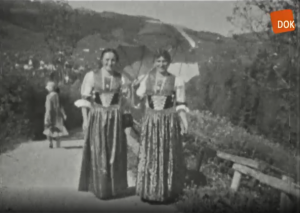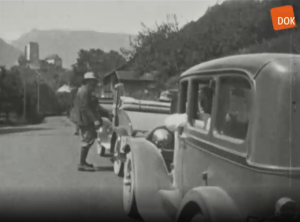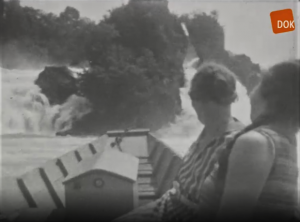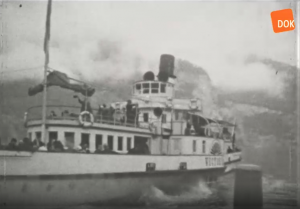Reise Bodensee und Schweiz : Différence entre versions
| (10 révisions intermédiaires par le même utilisateur non affichées) | |||
| Ligne 20 : | Ligne 20 : | ||
|lieuTournage=47.34609, 7.99273 | |lieuTournage=47.34609, 7.99273 | ||
|thematique=Cross-border tourism@ Religious feasts and events@ Places@ Natural and transformed landscape@ Heritage and tourism sites | |thematique=Cross-border tourism@ Religious feasts and events@ Places@ Natural and transformed landscape@ Heritage and tourism sites | ||
| + | |Resume_en=Travel to Switzerland and Lake Constance | ||
|Resume_de=Reise in die Schweiz und an den Bodensee | |Resume_de=Reise in die Schweiz und an den Bodensee | ||
| + | |Description_en=Tour of the zoo in Basel; Timetable of the ships from Constance; Ship landing stage, family in the restaurant, promenade by the lake; Collegiate Church in St. Gallen; Drive by car through mountain landscape; Women in costume; Car on country road; Women in costume on the way to the church and in front of the church; Girl with Käthe-Kruse doll, family in front of the car; Hike to the Ebenalp, family on the terrace; Alleys in Appenzell; Family in room, woman in costume, place <not identified>; Cars on the highway; Klamm <not identified; possibly Rappenloch gorge near Dornbirn>; | ||
| + | |||
| + | Family at the Rhine Falls near Schaffhausen, boat trip to the waterfalls); Drive through the Schächental and over the Klausenpass, snowball fight; Trip with the excursion boat on Lake Lucerne; Drive by car along Lake Lucerne; Lower town in Bregenz; Passengers board the Lake Constance ferry, music band on the quay, port in Lindau; Meersburg: tour of the old town, visit to the old and new castle; Ferry ride, seaplane; Mainau and Unteruhldingen landing stage; Domestic pigs; Sailing ship; Minster St. Nikolaus in Überlingen and in Birnau; Show car; Jetty at Lake Constance (probably Unteruhldingen), family eating on the terrace of a restaurant, sign 'Zu den Pfahlbauten'; Pile dwellings in Unteruhldingen, Baden im See; Evening atmosphere. // | ||
|Description_de=TC: 10.00:00:14: | |Description_de=TC: 10.00:00:14: | ||
Rundgang durch den Zoo in Basel (v.E.); Fahrplan der Schiffe ab Konstanz; Schiffsanlegestelle, Familie im Restaurant, Promenade am See (v.E.); Stiftskirche in St. Gallen (v.E.); Fahrt mit dem Auto durch Berglandschaft (v.E.); Frauen in Tracht; Auto auf Landstraße; Frauen in Tracht auf dem Weg zur Kirche u. vor der Kirche (v.E.); Mädchen mit Käthe-Kruse-Puppe, Familie vor dem Auto (v.E.); Wanderung auf den Ebenalp, Familie auf der Terrasse (v.E.); Gassen in Appenzell (v.E.); Familie in Stube, Frau in Tracht (v.E.), Ort <nicht identifiziert>; Autos auf der Landstraße; Klamm <nicht identifiziert; eventuell Rappenlochschlucht bei Dornbirn>; | Rundgang durch den Zoo in Basel (v.E.); Fahrplan der Schiffe ab Konstanz; Schiffsanlegestelle, Familie im Restaurant, Promenade am See (v.E.); Stiftskirche in St. Gallen (v.E.); Fahrt mit dem Auto durch Berglandschaft (v.E.); Frauen in Tracht; Auto auf Landstraße; Frauen in Tracht auf dem Weg zur Kirche u. vor der Kirche (v.E.); Mädchen mit Käthe-Kruse-Puppe, Familie vor dem Auto (v.E.); Wanderung auf den Ebenalp, Familie auf der Terrasse (v.E.); Gassen in Appenzell (v.E.); Familie in Stube, Frau in Tracht (v.E.), Ort <nicht identifiziert>; Autos auf der Landstraße; Klamm <nicht identifiziert; eventuell Rappenlochschlucht bei Dornbirn>; | ||
| Ligne 29 : | Ligne 33 : | ||
TC: 10:06:35:16: | TC: 10:06:35:16: | ||
Meersburg: Rundgang durch die Altstadt, Besuch des Alten und Neuen Schlosses (v.E.); Fahrt mit der Fähre, Wasserflugzeug (v.E.); Anlegestelle der Mainau und von Unteruhldingen (v.E.); Hausschweine; Segelschiff; Münster St. Nikolaus in Überlingen u. in Birnau (kurz); Schaustellerwagen (kurz); Anlegestelle am Bodensee (vmtl. Unteruhldingen), Familie beim Essen auf der Terrasse eines Restaurants, Schild <zu den Pfahlbauten> (v.E.); Pfahlbauten in Unteruhldingen, Baden im See (v.E.); Abendstimmung (v.E.). // | Meersburg: Rundgang durch die Altstadt, Besuch des Alten und Neuen Schlosses (v.E.); Fahrt mit der Fähre, Wasserflugzeug (v.E.); Anlegestelle der Mainau und von Unteruhldingen (v.E.); Hausschweine; Segelschiff; Münster St. Nikolaus in Überlingen u. in Birnau (kurz); Schaustellerwagen (kurz); Anlegestelle am Bodensee (vmtl. Unteruhldingen), Familie beim Essen auf der Terrasse eines Restaurants, Schild <zu den Pfahlbauten> (v.E.); Pfahlbauten in Unteruhldingen, Baden im See (v.E.); Abendstimmung (v.E.). // | ||
| + | |Contexte_et_analyse_en=[[Fichier:Schweiz 1.png|vignette|During the trips, traditional costumes were also documented in the film(Foto: LFS)]] | ||
| + | The black and white private film in 16mm format by the Freiburg architect Curt Balke is an impression of two family trips in 1930. A distinction must be made between a trip with two befriended couples in three cars to northern Switzerland and along Lake Constance and one Excursion by the Balke family alone to Lake Constance. The recordings show that these are middle-class families who have not suffered the consequences of the economic crisis and who can enjoy life. Even in this period, cars are a sure sign of prosperity, because only wealthy layers of society could afford an automobile at that time. On the trip they use the tourism offers that have developed since the 19th century. The people involved book tours on tourist ships and ferries and hike in the mountains with guides. There is a stop at bars and restaurants, the sights of the places are visited and extraordinary encounters and events are documented on film. | ||
| + | |||
| + | [[Fichier:Schweiz 2.png|vignette| Traveling by car was a certain luxury in 1930 (Foto: LFS)]] | ||
| + | |||
| + | In the Basel Zoo, where the film begins, around a dozen animals are shown in their enclosures within 40 seconds. Some guards' attempt to recapture a fleeing young camel has a humorous quality. A special motif is a group of women in traditional Appenzell costumes with elaborate hat decorations, which is definitely interesting from a folklore perspective. The trip to the Rhine Falls near Schaffhausen, where the open rowing boat comes very close to the wildly falling water, is particularly adventurous for the family. The filmmaker can convey this feeling very well in his pictures, as well as the fascination of the mountains and nature during the hikes. This is contrasted with the fascination with technology with cars, ships, fancy motor boats or the landing of a seaplane on Lake Constance. | ||
| + | |||
| + | [[Fichier:Schweiz 3.png|vignette|The Rhine Falls near Schaffhausen was already a tourist attraction (Foto: LFS)]] | ||
| + | |||
| + | Curt Balke is in prime age at 47, his ten-year-old daughter Kati with her pageboy hairstyle typical of the time can be seen in a shot with her Käte Kruse doll. Since Curt Balke can also be seen himself in some shots, he must have passed his 16mm camera on to others who shot with it. The trip to Switzerland of the three couples and the two teenagers begins at the Basel zoo, then the family goes to Lake Constance. Zoos were set up in the 19th century as a civil leisure activity with exotic animals from other continents. A series of excursions into the Swiss Alps then begins with Sankt Gallen. The first to Appenzell, then deeper into the mountains. Passes, gorges and lakes are visited. Later it goes back down to the Rhine Falls near Schaffhausen, then up again to discover Lake Lucerne. The last part of the film is an excursion by the Balke family to eastern Lake Constance. It is noteworthy that despite the time of crisis, they can afford such trips. With the recordings they are undoubtedly trying to create images for themselves to remember, but possibly also to show relatives and friends what they can afford. | ||
| + | |||
| + | [[Fichier:Schweiz 4.png|vignette|Boat tours were very popular on vacation (Foto: LFS)]] | ||
| + | |||
| + | From the mostly cheerful pictures one can see that these people happily go on discovery tours, that nature attracts them, that they admire its power and that they enjoy cultural experiences. They are interested in historical buildings, churches, castles, customs and traditions. It is a recreational and at the same time a cultural educational journey. However, the focus is on shots of nature and landscapes. The two girls are often in the picture with their activities, for which the cinematic memories may also have been recorded. The impression remains of a beautiful, funny and almost wistful family trip. With the medium of film, Curt Balke wanted to preserve the memories of the beautiful hours for the future. | ||
| + | |||
| + | The two trips take place in the summer of the 'crisis year' of 1930. The Weimar Republic found itself in a difficult political and economic situation. The Great Depression that sparked in the United States destroyed substantial parts of the economy. Between 1928 and 1933 bankruptcies doubled. Heinrich Brüning of the Center Party was Chancellor of the Reich, but did not have a majority in the Reichstag. With his 'system Brüning', he relied on 'emergency ordinances' from the Reich President von Hindenburg - bypassing the Reichstag that was actually responsible. Brüning's first cabinet was in office from March 1930 to October 1931. During these difficult times, poverty increased through unemployment and the discontent of large sections of the population. The National Socialist NSDAP became Germany's second largest party. The crisis also raged in Switzerland. The Swiss Federal Council decided to support endangered economic sectors, including the hotel industry as the central pillar of the tourist infrastructure, which supplied the country with considerable foreign currency. Despite the rise of right-wing conservative movements, Switzerland, unlike many other European countries, remained without political upheaval. | ||
| + | |||
| + | Paul Abel | ||
| + | |Contexte_et_analyse_de=[[Fichier:Schweiz 1.png|vignette|Bei den Reisen wurden auch Trachten im Film dokumentiert (Foto: LFS)]] | ||
| + | Bei dem schwarzweißen Privatfilm im 16mm-Format des Freiburger Architekten Curt Balke handelt es sich um Impressionen von zwei Reisen der Familie im Jahr 1930. Zu unterscheiden sind dabei eine Reise mit zwei befreundeten Paaren mit drei Autos in die nördliche Schweiz und entlang des Bodensees und ein Ausflug der Familie Balke an den Bodensee. Die Aufnahmen zeigen, dass es sich um gutbürgerliche Familien handelt, die nicht an den Folgen der Wirtschaftskrise zu leiden haben und das Leben genießen können. Autos sind schon in dieser Periode ein sicheres Zeichen von Wohlstand, denn nur wohlhabende Schichten der Gesellschaft konnten sich damals ein Automobil leisten. | ||
| + | |||
| + | [[Fichier:Schweiz 2.png|vignette|Das Reisen mit Auto war 1930 ein gewisser Luxus (Foto: LFS)]] | ||
| + | |||
| + | Man nutzt auf der Reise die angebotenen Tourismusangebote, die sich seit dem 19. Jahrhundert entwickelt haben. Die beteiligten Personen buchen Rundfahrten auf Touristenschiffen und Fähren und wandern in den Bergen mit Führern. Es wird eingekehrt in Lokale und Restaurants, die Sehenswürdigkeiten der Orte besichtigt und außergewöhnliche Begegnungen und Ereignisse filmisch dokumentiert. Im Basler Zoo, wo der Film beginnt, werden innerhalb von 40 Sekunden rund ein Dutzend Tiere in ihren Gehegen gezeigt. Humoristische Qualität hat der Versuch einiger Wärter, ein flüchtendes junges Kamel wieder einzufangen. Ein besonderes Motiv ist der Kirchgang einer Gruppe von Frauen in Appenzeller Tracht mit aufwändigem Hutschmuck, die volkskundlich auf jeden Fall interessant ist. Besonders abenteuerlich für die Familie ist die Fahrt beim Rheinfall bei Schaffhausen, wo das offene Ruderboot sehr nahe an das wild herabstürzende Wasser heranfährt. Der Filmemacher kann in seinen Bildern dieses Gefühl sehr gut vermitteln, ebenso die Faszination der Berge und Natur bei den Wanderungen. Kontrastiert wird dies mit der Faszination an Technik mit den Autos, Schiffen, schicken Motorbooten oder der Landung eines Wasserflugzeugs auf dem Bodensee. | ||
| + | |||
| + | [[Fichier:Schweiz 3.png|vignette|Der Rheinfall bei Schaffhausen war bereits eine Touristenattraktion (Foto: LFS)]] | ||
| + | |||
| + | Curt Balke ist mit 47 Jahren im besten Alter, seine zehnjährige Tochter Kati mit in der Zeit typischen Pagenfrisur ist in einer Einstellung mit ihrer Käte Kruse Puppe zu sehen. Da Curt Balke in manchen Einstellungen auch selbst zu sehen ist, muss er seine 16mm-Kamera an andere weitergegeben haben, die damit drehten. Die Schweiz-Reise der drei Ehepaare und der zwei Jugendlichen beginnt im Zoo in Basel, dann fährt die Familie an den Bodensee. Zoos wurden im 19. Jahrhundert als bürgerliche Freizeitgestaltung eingerichtet mit exotischen Tieren aus anderen Kontinenten. Danach beginnt mit Sankt Gallen eine Serie von Ausflügen in die Schweizer Alpen. Der erste nach Appenzell, dann tiefer ins Gebirge. Pässe, Schluchten und Seen werden besichtigt. Später geht es wieder hinab an den Rheinfall bei Schaffhausen, dann wieder bergauf zur Entdeckung des Vierwaldstättersees. Der letzte Teil des Films ist ein Ausflug der Familie Balke an den östlichen Bodensee. Es ist bemerkenswert, dass sie sich solche Ausflüge trotz der Krisenzeit leisten können. Mit den Aufnahmen versuchen sie zweifelsohne, sich Bilder für die Erinnerung zu schaffen, aber möglicherweise auch Verwandten und Freunden zu zeigen, was sie sich leisten können. | ||
| + | |||
| + | [[Fichier:Schweiz 4.png|vignette|Bootstouren waren im Urlaub sehr beliebt (Foto: LFS)]] | ||
| + | |||
| + | Aus den meist heiteren Bildern kann man deuten, dass diese Menschen fröhlich auf Entdeckungstouren gehen, dass die Natur sie anzieht, dass sie deren Kraft bewundern und dass sie Freude an kulturellen Erlebnissen haben. Sie interessieren sich für historische Gebäude, Kirchen, Schlösser, für Sitten und Gebräuche. Es ist eine Erholungs- und zugleich eine kulturelle Bildungsreise. Im Zentrum stehen jedoch die Aufnahmen der Natur und Landschaften. Oft im Bild sind die beiden Mädchen mit ihren Aktivitäten, für die möglicherweise die filmischen Erinnerungen auch aufgenommen wurden. Es bleibt der Eindruck einer schönen, lustigen und fast schon sehnsuchtsvollen Familienreise. Mit dem Medium Film wollte Curt Balke die Erinnerung an die schönen Stunden für die Zukunft bewahren. | ||
| + | |||
| + | Die beiden Reisen finden im Sommer des ‚Krisenjahres‘ 1930 statt. Die Weimarer Republik befand sich in einer schwierigen politischen und wirtschaftlichen Situation. Die in den Vereinigten Staaten ausgelöste Weltwirtschaftskrise zerstörte wesentliche Teile der Wirtschaft. Zwischen 1928 und 1933 verdoppelten sich die Konkurse. Heinrich Brüning von der Zentrumspartei war Reichskanzler, besaß aber keine Mehrheit im Reichstag. Er stützte sich mit seinem System Brüning auf ‚Notverordnungen‘ des Reichspräsidenten von Hindenburg – am eigentlich zuständigen Reichstag vorbei. Das erste Kabinett Brünings amtierte von März 1930 bis Oktober 1931. In diesen schwierigen Zeiten wuchsen die Verarmung durch Arbeitslosigkeit und die Unzufriedenheit großer Teile der Bevölkerung. Die nationalsozialistische NSDAP wurde Deutschlands zweitstärkste Partei. Die Krise tobte ebenfalls in der Schweiz. Der Schweizer Bundesrat entschloss sich, gefährdete wirtschaftliche Sektoren zu unterstützen, unter anderem das Hotelgewerbe als zentrale Säule der touristischen Infrastruktur, die dem Lande erhebliche Devisen zuführte. Trotz des Emporkommens von rechtskonservativen Bewegungen blieb die Schweiz, im Gegensatz zu vielen anderen Ländern Europas, ohne politische Umwälzungen. | ||
| + | Paul Abel | ||
| + | |Bibliographie=HACHTMANN, Rüdiger, Tourismus und Tourismusgeschichte, Docupedia-Zeitgeschichte, 22.12.2010, http://docupedia.de/zg/hachtmann_tourismusgeschichte_v1_de_2010 | ||
| + | (konsultiert 30.12.2020); STURM, Reinhard, Zerstörung der Demokratie 1930-1932; Bundeszentrale für politische Bildung: https://www.bpb.de/geschichte/nationalsozialismus/dossier-nationalsozialismus/39537/zerstoerung-der-demokratie (konsultiert 4.1.2021); MÜLLER, Philipp, Die Schweiz in der Krise, (1929-1936): Währungs-, Finanz-; Wirtschafts- und Sozialpolitik der schweizerischen Eidgenossenschaft; Schweizerisches Jahrbuch für Wirtschafts- und Sozialgeschichte, Band 27, 2012: | ||
| + | https://www.e-periodica.ch/cntmng?pid=sgw-002:2012:27::320 (konsultiert 4.1.2021). | ||
}} | }} | ||
Version actuelle datée du 19 mars 2021 à 17:39
Résumé
Description
Tour of the zoo in Basel; Timetable of the ships from Constance; Ship landing stage, family in the restaurant, promenade by the lake; Collegiate Church in St. Gallen; Drive by car through mountain landscape; Women in costume; Car on country road; Women in costume on the way to the church and in front of the church; Girl with Käthe-Kruse doll, family in front of the car; Hike to the Ebenalp, family on the terrace; Alleys in Appenzell; Family in room, woman in costume, place <not identified>; Cars on the highway; Klamm <not identified; possibly Rappenloch gorge near Dornbirn>;
Family at the Rhine Falls near Schaffhausen, boat trip to the waterfalls); Drive through the Schächental and over the Klausenpass, snowball fight; Trip with the excursion boat on Lake Lucerne; Drive by car along Lake Lucerne; Lower town in Bregenz; Passengers board the Lake Constance ferry, music band on the quay, port in Lindau; Meersburg: tour of the old town, visit to the old and new castle; Ferry ride, seaplane; Mainau and Unteruhldingen landing stage; Domestic pigs; Sailing ship; Minster St. Nikolaus in Überlingen and in Birnau; Show car; Jetty at Lake Constance (probably Unteruhldingen), family eating on the terrace of a restaurant, sign 'Zu den Pfahlbauten'; Pile dwellings in Unteruhldingen, Baden im See; Evening atmosphere. //
Contexte et analyse
The black and white private film in 16mm format by the Freiburg architect Curt Balke is an impression of two family trips in 1930. A distinction must be made between a trip with two befriended couples in three cars to northern Switzerland and along Lake Constance and one Excursion by the Balke family alone to Lake Constance. The recordings show that these are middle-class families who have not suffered the consequences of the economic crisis and who can enjoy life. Even in this period, cars are a sure sign of prosperity, because only wealthy layers of society could afford an automobile at that time. On the trip they use the tourism offers that have developed since the 19th century. The people involved book tours on tourist ships and ferries and hike in the mountains with guides. There is a stop at bars and restaurants, the sights of the places are visited and extraordinary encounters and events are documented on film.
In the Basel Zoo, where the film begins, around a dozen animals are shown in their enclosures within 40 seconds. Some guards' attempt to recapture a fleeing young camel has a humorous quality. A special motif is a group of women in traditional Appenzell costumes with elaborate hat decorations, which is definitely interesting from a folklore perspective. The trip to the Rhine Falls near Schaffhausen, where the open rowing boat comes very close to the wildly falling water, is particularly adventurous for the family. The filmmaker can convey this feeling very well in his pictures, as well as the fascination of the mountains and nature during the hikes. This is contrasted with the fascination with technology with cars, ships, fancy motor boats or the landing of a seaplane on Lake Constance.
Curt Balke is in prime age at 47, his ten-year-old daughter Kati with her pageboy hairstyle typical of the time can be seen in a shot with her Käte Kruse doll. Since Curt Balke can also be seen himself in some shots, he must have passed his 16mm camera on to others who shot with it. The trip to Switzerland of the three couples and the two teenagers begins at the Basel zoo, then the family goes to Lake Constance. Zoos were set up in the 19th century as a civil leisure activity with exotic animals from other continents. A series of excursions into the Swiss Alps then begins with Sankt Gallen. The first to Appenzell, then deeper into the mountains. Passes, gorges and lakes are visited. Later it goes back down to the Rhine Falls near Schaffhausen, then up again to discover Lake Lucerne. The last part of the film is an excursion by the Balke family to eastern Lake Constance. It is noteworthy that despite the time of crisis, they can afford such trips. With the recordings they are undoubtedly trying to create images for themselves to remember, but possibly also to show relatives and friends what they can afford.
From the mostly cheerful pictures one can see that these people happily go on discovery tours, that nature attracts them, that they admire its power and that they enjoy cultural experiences. They are interested in historical buildings, churches, castles, customs and traditions. It is a recreational and at the same time a cultural educational journey. However, the focus is on shots of nature and landscapes. The two girls are often in the picture with their activities, for which the cinematic memories may also have been recorded. The impression remains of a beautiful, funny and almost wistful family trip. With the medium of film, Curt Balke wanted to preserve the memories of the beautiful hours for the future.
The two trips take place in the summer of the 'crisis year' of 1930. The Weimar Republic found itself in a difficult political and economic situation. The Great Depression that sparked in the United States destroyed substantial parts of the economy. Between 1928 and 1933 bankruptcies doubled. Heinrich Brüning of the Center Party was Chancellor of the Reich, but did not have a majority in the Reichstag. With his 'system Brüning', he relied on 'emergency ordinances' from the Reich President von Hindenburg - bypassing the Reichstag that was actually responsible. Brüning's first cabinet was in office from March 1930 to October 1931. During these difficult times, poverty increased through unemployment and the discontent of large sections of the population. The National Socialist NSDAP became Germany's second largest party. The crisis also raged in Switzerland. The Swiss Federal Council decided to support endangered economic sectors, including the hotel industry as the central pillar of the tourist infrastructure, which supplied the country with considerable foreign currency. Despite the rise of right-wing conservative movements, Switzerland, unlike many other European countries, remained without political upheaval.
Paul AbelBibliographie
HACHTMANN, Rüdiger, Tourismus und Tourismusgeschichte, Docupedia-Zeitgeschichte, 22.12.2010, http://docupedia.de/zg/hachtmann_tourismusgeschichte_v1_de_2010
(konsultiert 30.12.2020); STURM, Reinhard, Zerstörung der Demokratie 1930-1932; Bundeszentrale für politische Bildung: https://www.bpb.de/geschichte/nationalsozialismus/dossier-nationalsozialismus/39537/zerstoerung-der-demokratie (konsultiert 4.1.2021); MÜLLER, Philipp, Die Schweiz in der Krise, (1929-1936): Währungs-, Finanz-; Wirtschafts- und Sozialpolitik der schweizerischen Eidgenossenschaft; Schweizerisches Jahrbuch für Wirtschafts- und Sozialgeschichte, Band 27, 2012:
- ↑ Cette fiche est en cours de rédaction. À ce titre elle peut être inachevée et contenir des erreurs.









